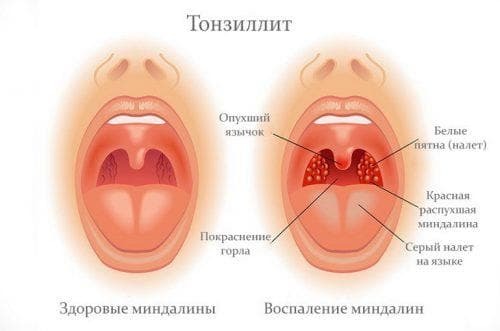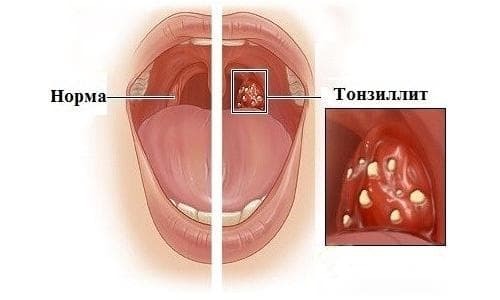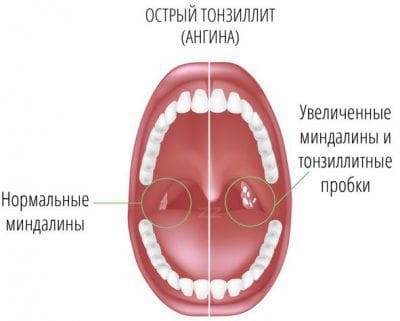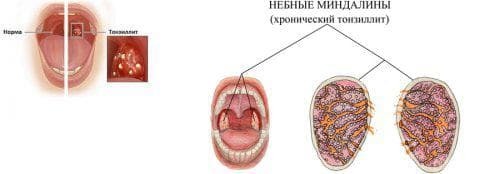
Tonsillitis is a common disease that affects both adults and children. Its peculiarity is that against the background of a certain pathogen an inflammatory process is formed, which affects the palatine tonsils. The disease can flow in two forms - acute and chronic. Each of them has its own symptomatology and flow characteristics.
Contents
- 1 How the acute illness
- 2 manifests itself How the chronic disease
- 3 manifests Diagnostic features in adults
- 4 Diagnostic features in children
How the acute illness
manifests itself The acute form of the disease is characterized by severe symptoms. All manifestations can be detected immediately after the development of inflammation, due to which it is possible to carry out therapy in time and to exclude the possibility of complications. In general, the disease lasts no longer than 2 weeks.

In the photo, the tonsillitis
looks like. Although the acute form has much in common with chronic, it has its own symptoms:
- at night, the patient has a strong snoring that is not characteristic of him in ordinary life;
- poor sleep;
- in the nasopharynx is formed a lot of mucus;
- temperature rise to high marks.
These are the primary signs of acute angina. But there are secondary symptoms that manifest as otitis or rash. The initial stage of pathology makes itself felt in the form of a cutting pain. Sometimes it is so strong that the patient is not even able to talk.
Inflammation gives an impetus to the formation of a purulent deposit on the glands. It can be concentrated in the form of small islets or completely affect the pharynx. If we compare the angina of viral and bacterial etiology, then the first one differs in the general condition of the patient. Initially, they are similar, then in the future the virus runs a little easier and can be quickly treated.
On video signs of tonsillitis:
To treat the acute form of the disease is much easier and easier than chronic. It is important not only to eliminate painful and unpleasant symptoms, but also to quash the underlying factor. In this case, treatment of acute form has a complex approach.
How chronic disease manifests itself
The main symptom of the chronic form of the disease is a strong soreness in the throat. Its intensity is determined by the shape of the current pathology. The pain syndrome can be weakly perceived or strong. But while it is of a permanent nature, and fades with the use of pain medications.
Symptoms of chronic tonsillitis include:
- dry mouth, burning sensation;
- presence of white plaque, which affects the tongue and glands;
- fever or chills;
- enlargement of the lymph nodes concentrated on the neck, and also their soreness;
- enlargement of the glands, hyperemia and swelling of the back wall of the throat;
- general weakness, which is caused by intoxication of the body;
- poor appetite;
- difficulty in nasal breathing, cutting pain in the ears;
- sensation of nausea and vomiting, accompanied by painful sensations in the peritoneum.
Chronic tonsillitis is determined by frequent and persistent formation. It occurs after a previous infectious disease or when affected by coccal bacteria. In addition, the frequent cause of its development is untreated acute angina.

In the photo - chronic tonsillitis
When an infection has entered the human body, it inflicts damage to the tonsils on which cracks form. Later, they penetrate food fragments or keratinized cells of the body. All this has a positive effect on the development of the inflammatory process. At the time of remission, the disease may not make itself felt at all.
 And here's how to treat tonsillitis at home, and what medications should be used on your own, will help understand this article.
And here's how to treat tonsillitis at home, and what medications should be used on your own, will help understand this article.
It will also be interesting to learn how to cure tonsillitis with folk remedies.
Which antibiotic for tonsillitis and pharyngitis is worth using most often, will help to understand this article: http: //prolor.ru/g/lechenie/ lechenie-faringita-antibiotikami.html
Perhaps you will also be interested to know what analogues of Tonzillon exist and what their name is.
Influence on the development of exacerbation of tonsillitis may decrease immunity in the autumn-winter period due to beriberi.
Chronic form of tonsillitis can be divided into several groups. Each of them is characterized by its symptoms and the nature of the current.
For a simple form, there are few symptoms of .These include pain and discomfort during swallowing, an increase in tonsils, the formation of a purulent plaque. A person has a strong fever, he feels broken. The disease takes a protracted character. At the time of remission, all manifestations of the disease are absent.

In the photo - a simple form of tonsillitis
Allergic form of the disease is considered more dangerous. This is due to the fact that the infection does not make itself felt, while the organism is intoxicated. A little later a person can visit pain in the solar plexus and joints. There is a failure in the work of the heart and kidneys, and the body's temperature increases to 37-37.2 degrees.

On the photo - allergic form of tonsillitis
Diagnostic features in adults
To establish an accurate diagnosis, the patient should contact the therapist at the hospital. In the doctor's office, the patient should tell the therapist about all the symptoms that arise. He then performs an external examination of the patient for redness of the swelling of the mucous membrane of the affected tonsils and tissues that are in the environment. Also, the diagnosis involves probing the lymph nodes, as a result of which one can detect a strong increase in them and soreness.
On video diagnosis of tonsillitis in adults:
In addition, the patient must donate blood, and in the analysis results the amount of lymphocytes rises at least to 20 * 109 / l. An adult can also be sent to X-ray, ECG and ultrasound.
You may also be interested in learning how to use Tonzilotren for children.
But whether it is possible to Tonzillon during pregnancy, and how effective this tool is, will help to understand this information.
It will also be interesting to learn how to use and apply Tonzylgon and Pills.
For those who want to know more about what differ Sinupret and Tonzilgon, and what means the best.
And in this article, you can learn more about the instructions for using a nebulizer for inhalations with Tonzigon.
Diagnostic features in children
When a doctor diagnoses a child, the doctor sends him for testing, performs an examination, and also performs instrumental and laboratory tests.
Thanks to pharyngoscopy, it is possible to detect pathological changes of palatine arch, loose areas of tonsils, places of new concentrations. With the help of a button probe, one can understand the depth of lacunae, the presence of adhesions and adhesions. When probing the lymph nodes, regional lymphadenitis is determined.
Laboratory diagnostics includes clinical analysis of blood and urine, bacteriological seeding from the throat, determination of C-reactive white. If the chronic form of the disease occurs in an uncompensated form, then a consultation of such physicians as a rheumatologist, cardiologist and nephrologist will be required.
On video diagnostics of tonsillitis in children:
To exclude the formation of new infectious foci, it is worthwhile to show the patient to the dentist.
Additional diagnostic methods include:
- ECG,
- EchoCG,
- ultrasound of the kidney,
- radiography of the paranasal sinuses,
- blood culture for sterility,
- tuberculin tests.
Tonsillitis is an insidious and dangerous disease, the symptoms of which need to be known "in person".This is the only way to get to the doctor on time and get rid of the disease as quickly as possible. Otherwise, the chronization of the process can not be avoided, and this leads to the development of serious complications.
